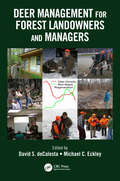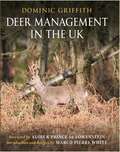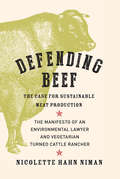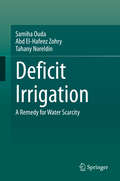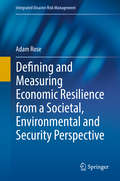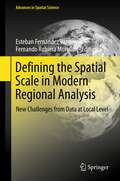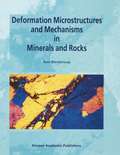- Table View
- List View
Deer Management for Forest Landowners and Managers
by David S. deCalesta and Michael C. EckleyThis book is designed to help landowners and forestry professionals develop, implement, and monitor programs to manage both deer and forests with emphasis on resolving deer impact issues. Chapters cover management strategies through identifying and setting goals; managing deer populations and deer impact on land; economics of forest, deer, and impact management; human dimensions of deer management; and developing and implementing integrated management plans. The book presents an integrated, quantitative approach for managing deer populations and impacts so users can manage forest resources sustainably.
Deer Management for Forest Landowners and Managers
by David S. DeCalesta Michael C. EckleyThis book is designed to help landowners and forestry professionals develop, implement, and monitor programs to manage both deer and forests with emphasis on resolving deer impact issues. Chapters cover management strategies through identifying and setting goals; managing deer populations and deer impact on land; economics of forest, deer, and impact management; human dimensions of deer management; and developing and implementing integrated management plans. The book presents an integrated, quantitative approach for managing deer populations and impacts so users can manage forest resources sustainably.
Deer Management in the UK
by Dominic GriffithWith 25 years of professional deer management experience, the author shows how to manage deer to their best potential. Whilst much deer management can result in a harassed and pressured deer population, this invaluable guide demonstrates how a more gentle approach has the benefit of an unstressed, visible and truly manageable population of deer. The book concentrates mainly on roe and includes detailed case studies; a modern approach to cull planning; collaborative management techniques, plus 10 delicious venison recipes from 3-star Michelin chef, Marco Pierre White
Defects in Liquid Crystals: Computer Simulations, Theory and Experiments (NATO Science Series II: Mathematics, Physics and Chemistry #43)
by Oleg D. Lavrentovich Paolo Pasini Claudio Zannoni Slobodan ZumerTopological defects are the subject of intensive studies in many different branches of physics ranging from cosmology to liquid crystals and from elementary particles to colloids and biological systems. Liquid crystals are fascinating materials which present a great variety of these mathematical objects and can therefore be considered as an extremely useful laboratory for topological defects. This book is the first attempt to present together complementary approaches to the investigations of topological defects in liquid crystals using theory, experiments and computer simulations.
Defence from Floods and Floodplain Management (NATO Science Series E: #299)
by John Gardiner Odon Starosolszky V. YevjevichDefence from Floods and Floodplain Management discusses all aspects of floodplain management related to defence from floods, including specific issues such as the maintenance of flood defences, and reveals many aspects of a more holistic approach to the management of flood risk, expanding the structural/non-structural debate into prevention and cure in the floodplain and its catchment. Recent experience in many countries is recounted by experts from Hungary, Austria, Greece, Italy, the Netherlands, Portugal, the UK and the USA.
Defence Nuclear Waste Disposal in Russia: International Perspective (NATO Science Partnership Subseries: 1 #18)
by M. J. Stenhouse Vladimir I. KirkoSignificant amounts of liquid and solid radioactive waste have been generated in Russia during the production of nuclear weapons, and there is an urgent need to find suitable ways to manage these wastes in a way that protects both the current population and future generations. This book contains contributions from pure and applied scientists and other representatives from Europe, North America, and Russia, who are, or have been, actively involved in the field of radioactive waste management and disposal. First-hand experience of specific problems associated with defence-related wastes in the USA and the Russian Federation is presented, and current plans are described for the disposal of solid wastes arising from civilian nuclear power production programmes in other countries, including Belgium, Bulgaria, Canada, Germany and the UK. The book provides a good insight into ongoing research at local and national level within Russia, devoted to the safe disposal of defence-related radioactive waste. It also demonstrates how existing expertise and technology from civilian nuclear waste management programmes can be applied to solving the problems created by nuclear defence programmes. Contributions address methods of immobilisation, site selection methodology, site characterisation techniques and data interpretation, the key elements of safety/performance assessments of planned deep (geological) repositories for radioactive waste, and radionuclide transport modelling. Concerns associated with certain specific nuclear waste disposal concepts and repository sites are also presented.
Defending Beef: The Case for Sustainable Meat Production
by Nicolette Hahn NimanFor decades it has been nearly universal dogma among environmentalists and health advocates that cattle and beef are public enemy number one. But is the matter really so clear cut? Hardly, argues environmental lawyer turned rancher Nicolette Hahn Niman in her new book, Defending Beef. The public has long been led to believe that livestock, especially cattle, erode soils, pollute air and water, damage riparian areas, and decimate wildlife populations. In Defending Beef, Hahn Niman argues that cattle are not inherently bad for either the Earth or our own nutritional health. In fact, properly managed livestock play an essential role in maintaining grassland ecosystems by functioning as surrogates for herds of wild ruminants that once covered the globe. Hahn Niman argues that dispersed, grass-fed, small-scale farms can and should become the basis for American food production, replacing the factory farms that harm animals and the environment. The author—a longtime vegetarian—goes on to dispel popular myths about how eating beef is bad for our bodies. She methodically evaluates health claims made against beef, demonstrating that such claims have proven false. She shows how foods from cattle—milk and meat, particularly when raised entirely on grass—are healthful, extremely nutritious, and an irreplaceable part of the world’s food system. Grounded in empirical scientific data and with living examples from around the world, Defending Beef builds a comprehensive argument that cattle can help to build carbon-sequestering soils to mitigate climate change, enhance biodiversity, help prevent desertification, and provide invaluable nutrition. Defending Beef is simultaneously a book about big ideas and the author’s own personal tale—she starts out as a skeptical vegetarian and eventually becomes an enthusiastic participant in environmentally sustainable ranching. While no single book can definitively answer the thorny question of how to feed the Earth’s growing population, Defending Beef makes the case that, whatever the world’s future food system looks like, cattle and beef can and must be part of the solution.
Defense and Recognition in the Climate Crisis: How to Communicate About Truths, Facts and Opinions
by Barbara StrohscheinTruths, facts and opinions on the climate issue are often met with psychological or social defense, both publicly and privately. Based on selected psychological and philosophical theories as well as data material, this book shows how defense comes about, how it works, and how, on the other hand, the necessary recognition can succeed on various levels. It is only through recognition that constructive discourse becomes possible. This book offers all the basics to be able to theoretically and practically solve communication conflicts between defense and recognition in the climate crisis.
Defense and the Environment: Effective Scientific Communication (Nato Science Series: IV: #39)
by Ronald A. Kreizenbeck John J. Barich KatarinaMahutovaThe success of Environmental Management Systems (EMS) at military facilities requires support and leadership from the highest levels of management, adequate resources for development and implementation, and an acknowledgement by the military commanders that EMS is an integral part of facilities and operations management. The theme of this book is the effective communication of environmental concerns in a changing military environment.
Deficit Irrigation: A Remedy for Water Scarcity
by Abd El-Hafeez Zohry Samiha Ouda Tahany NoreldinThis book focuses on proving that deficit irrigation could play an important role in increasing food production in times of water scarcity. Although the application of deficit irrigation can involve loss in crop productivity, it still secures water to be use in cultivating more lands and producing more food. The following questions are discussed and the authors offer solutions to these problems:Will the production, on a national level, resulting from these new added areas compensate yield losses attained by application of deficit irrigation?Is it possible to use deficit irrigation practice to reduce the applied irrigation water to certain crops that have a surplus in their production, and direct this saved water to cultivate new areas with crops have low self-sufficiency ratios? Under climate change in 2030, would deficit irrigation practice have the same role it plays under the current conditions? This book will appeal to students and researchers involved with water scarcity and food security.
Defining and Measuring Economic Resilience from a Societal, Environmental and Security Perspective (Integrated Disaster Risk Management)
by Adam RoseThis volume presents an economic framework for the analysis of resilience in relation to societal, environmental, and personal security perspectives. It offers a rigorous definition of economic resilience and an operational metric, and it shows how they can be applied to measuring and applying the concept to private and public decision making. Major dimensions of resilience and their implications for human development are explored. Resilience is emphasized as a coping mechanism for dealing with short-term crises, such as natural disasters and acts of terrorism. As well, the author shows how lessons learned in the short-run out of necessity and through the application of human ingenuity can be incorporated into long-run sustainability practices. In part, this opportunity stems from viewing resilience as a process, one that enhances individual and societal competencies. The book links economic resilience to several other disciplines and examines the relationship between resilience and various other key concepts such as vulnerability, adaptation, and sustainability. It scrutinizes the measurement of economic resilience in terms of temporal, spatial, and scale dimensions. It examines the time-path of resilience and relates it to the recovery process.This work also looks closely at progress on the formulation of resilience indices and stresses the importance of actionable variables. It presents a risk-management framework, including aspects of cost-effectiveness and cost-benefit analysis. Additionally, it explores the role of resilience in relation to the co-benefits of disaster risk management.
Defining Effective Transboundary Water Cooperation (Earthscan Studies in Water Resource Management)
by Melissa McCrackenThis book establishes a framework for defining transboundary water cooperation and a methodology for evaluating its effectiveness, which will contribute to more effective and therefore successful cooperation processes. With the increasing focus on transboundary cooperation as a part of the Sustainable Development Goal Framework, there is global recognition of transboundary water cooperation as a tool for improved governance and management of transboundary surface and groundwaters. However, there is not an agreed upon definition of transboundary water cooperation in the literature or in practice. This book develops the Four Frames of Transboundary Water Cooperation, which is a neutral modular framework for developing context-specific explanatory definitions of transboundary water cooperation in basins and aquifers. The Four Frames of Cooperation are legal, institutional, relational, and outcome. However, we need to move beyond defining cooperation to understand better measures of the quality and effectiveness of cooperative processes. The Weighted Model of Effective Cooperation presents a first step in qualitatively evaluating the effectiveness of transboundary water cooperation. This model defines effective transboundary water cooperation and operationalizes a method to evaluate the effectiveness of cooperative processes over internationally shared waters. Effective cooperation emphasizes the relational and outcome frames of cooperation while working towards equitability and sustainability. Together, the Four Frames of Cooperation and the Weighted Model of Effective Cooperation will improve the understanding of cooperation and encourage a detailed evaluation of the quality, success, and effectiveness of cooperative processes. This book will be of great interest to students and scholars of water resource management, water governance, and environmental politics. It will also appeal to policymakers and professionals working in the fields of water conflict, water diplomacy, and international cooperation.
Defining Effective Transboundary Water Cooperation (Earthscan Studies in Water Resource Management)
by Melissa McCrackenThis book establishes a framework for defining transboundary water cooperation and a methodology for evaluating its effectiveness, which will contribute to more effective and therefore successful cooperation processes. With the increasing focus on transboundary cooperation as a part of the Sustainable Development Goal Framework, there is global recognition of transboundary water cooperation as a tool for improved governance and management of transboundary surface and groundwaters. However, there is not an agreed upon definition of transboundary water cooperation in the literature or in practice. This book develops the Four Frames of Transboundary Water Cooperation, which is a neutral modular framework for developing context-specific explanatory definitions of transboundary water cooperation in basins and aquifers. The Four Frames of Cooperation are legal, institutional, relational, and outcome. However, we need to move beyond defining cooperation to understand better measures of the quality and effectiveness of cooperative processes. The Weighted Model of Effective Cooperation presents a first step in qualitatively evaluating the effectiveness of transboundary water cooperation. This model defines effective transboundary water cooperation and operationalizes a method to evaluate the effectiveness of cooperative processes over internationally shared waters. Effective cooperation emphasizes the relational and outcome frames of cooperation while working towards equitability and sustainability. Together, the Four Frames of Cooperation and the Weighted Model of Effective Cooperation will improve the understanding of cooperation and encourage a detailed evaluation of the quality, success, and effectiveness of cooperative processes. This book will be of great interest to students and scholars of water resource management, water governance, and environmental politics. It will also appeal to policymakers and professionals working in the fields of water conflict, water diplomacy, and international cooperation.
Defining the Spatial Scale in Modern Regional Analysis: New Challenges from Data at Local Level (Advances in Spatial Science)
by Esteban Fernández Vázquez and Fernando Rubiera MorollónThis book explores different approaches to defining the concept of region depending on the specific question that needs to be answered. While the typical administrative spatial data division fits certain research questions well, in many cases, defining regions in a different way is fundamental in order to obtain significant empirical evidence. The book is divided into three parts: The first part is dedicated to a methodological discussion of the concept of region and the different potential approaches from different perspectives. The problem of having sufficient information to define different regional units is always present. This justifies the second part of the book, which focuses on the techniques of ecological inference applied to estimating disaggregated data from observable aggregates. Finally, the book closes by presenting several applications that are in line with the functional areas definition in regional analysis.
Deforestation: Social Dynamics in Watersheds and Mountain Ecosystems (Routledge Library Editions: Ecology #5)
by J. Ives D. C. PittOriginally published in 1988 Deforestation examines deforestation as a major environmental and development problem. It examines the issues of forests being cut in tropical and mountain areas, and how acid rain, pollution and disease wreak havoc in temperate zones. Some of the worst effects of deforestation have been changes in the world’s climate system, erosion and flooding, desertification, wood short-ages and the disappearance of some floral and fauna species. This book challenges the belief that deforestation is due to entirely rapid population growth and agricultural expansion and emphasises the effects of commercial exploitation and poor planning and management. In concludes with a programme for reforestation using agro-forestry, appropriate cottage industries, improved international programmes, local land reforms and community participation.
Deforestation: Social Dynamics in Watersheds and Mountain Ecosystems (Routledge Library Editions: Ecology #5)
by J. Ives; D.C. PittOriginally published in 1988 Deforestation examines deforestation as a major environmental and development problem. It examines the issues of forests being cut in tropical and mountain areas, and how acid rain, pollution and disease wreak havoc in temperate zones. Some of the worst effects of deforestation have been changes in the world’s climate system, erosion and flooding, desertification, wood short-ages and the disappearance of some floral and fauna species. This book challenges the belief that deforestation is due to entirely rapid population growth and agricultural expansion and emphasises the effects of commercial exploitation and poor planning and management. In concludes with a programme for reforestation using agro-forestry, appropriate cottage industries, improved international programmes, local land reforms and community participation.
Deforesting the Earth: From Prehistory to Global Crisis, An Abridgment
by Michael Williams“Anyone who doubts the power of history to inform the present should read this closely argued and sweeping survey. This is rich, timely, and sobering historical fare written in a measured, non-sensationalist style by a master of his craft. One only hopes (almost certainly vainly) that today’s policymakers take its lessons to heart.”—Brian Fagan, Los Angeles Times Published in 2002, Deforesting the Earth was a landmark study of the history and geography of deforestation. Now available as an abridgment, this edition retains the breadth of the original while rendering its arguments accessible to a general readership. Deforestation—the thinning, changing, and wholesale clearing of forests for fuel, shelter, and agriculture—is among the most important ways humans have transformed the environment. Surveying ten thousand years to trace human-induced deforestation’s effect on economies, societies, and landscapes around the world, Deforesting the Earth is the preeminent history of this process and its consequences. Beginning with the return of the forests after the ice age to Europe, North America, and the tropics, Michael Williams traces the impact of human-set fires for gathering and hunting, land clearing for agriculture, and other activities from the Paleolithic age through the classical world and the medieval period. He then focuses on forest clearing both within Europe and by European imperialists and industrialists abroad, from the 1500s to the early 1900s, in such places as the New World, India, and Latin America, and considers indigenous clearing in India, China, and Japan. Finally, he covers the current alarming escalation of deforestation, with our ever-increasing human population placing a potentially unsupportable burden on the world’s forests.
Deformation Analysis in Soft Ground Improvement (Geotechnical, Geological and Earthquake Engineering #18)
by Jinchun Chai John P. CarterThis book deals with the behaviour of soft ground improved by some of the more common methods, including the installation of prefabricated vertical drains (PVDs), or the installation of soil-cement columns formed by deep mixing, or the preloading of soft ground by application of a vacuum pressure in addition to, or instead of, a surcharge loading. In particular, it describes the theories and the numerical modelling techniques that may be applied to these soft ground improvement schemes to estimate the immediate and time-dependent mechanical response of the in situ soil. Particular emphasis has been placed on methods that reliably predict ground deformations associated with ground improvement techniques.The book commences with a brief description of the various ground improvement methods and then describes general techniques for modelling the behaviour of soft clay subsoils by the finite element method, as well as details of the methods for modelling soft soils improved by the installation of PVDs. It also includes chapters describing the theory of vacuum consolidation and methods for calculating vacuum pressure-induced ground deformation, as well as a theory which can be used to predict the response of soft ground improved by the installation of soil-cement columns. An important distinguishing feature of this book is the routine use of comparisons of predictions of the proposed models with the results of laboratory studies, and particularly field case studies, in order to validate the proposed methods of analysis. The field case histories are from soft soil sites at various locations around the world.The book is directed towards students of geotechnical engineering as well as geotechnical practitioners. In the main it provides complete derivations of most of the important theoretical results, as the intention was to write a book that could be used as both a teaching text and a reference work for students and practitioners.Audience: The book is intended for geotechnical practitioners as well as for students.
Deformation and Failure Mechanism of Excavation in Clay Subjected to Hydraulic Uplift (Advanced Topics in Science and Technology in China)
by Yi Hong Lizhong WangThis book presents the latest experimental and numerical analysis work in the field of ground deformation and base instability of deep excavations in soft clay subjected to hydraulic uplift. The authors’ latest research findings, based on dimensional analyses, well-instrumented full-scale field tests, systematic coupled-consolidation finite element analyses and centrifuge tests are reported. This book shows how to systematically approach a complex geotechnical problem, from identifying existing problems, reviewing literature, to dimensional and numerical analyses, validation through full-scale testing and centrifuge model testing. The methodologies are also introduced as major tools adopted in geotechnical research.
Deformation and Failure Mechanism of Rock Tunnels under Earthquake Loading
by Yujing Jiang Xuepeng ZhangSeismic damage to rock tunnels from recent earthquakes indicates an urgent need for seismic assessment and aseismic design of underground structures. This book offers a comprehensive account of seismic performance and the response of underground structures under earthquake loading, necessary for adequate assessment and design. The book presents research methods for the rate-dependent mechanical behavior of rock and for the seismic behavior of underground structures. It describes analytical solutions to investigate the seismic response of tunnels subjected to seismic waves, toward an improved quantitative understanding of the seismic deformation and failure mechanism in both longitudinal and transversal aspects. A performance-based restoration design criterion and aseismic design are also proposed for future tunnel planning. Includes a detailed case study for the seismic performance assessment of rock tunnels under earthquake loading Explores the relationship between seismic damage to underground structures and ground deformation Covers a range of issues from mechanisms, analysis, assessment and design of both new tunnels and restoration projects The book is ideal for earthquake engineers and researchers, and will also be of interest to contractors, clients, researchers, lecturers, and advanced students working on tunnel engineering.
Deformation and Failure Mechanism of Rock Tunnels under Earthquake Loading
by Yujing Jiang Xuepeng ZhangSeismic damage to rock tunnels from recent earthquakes indicates an urgent need for seismic assessment and aseismic design of underground structures. This book offers a comprehensive account of seismic performance and the response of underground structures under earthquake loading, necessary for adequate assessment and design. The book presents research methods for the rate-dependent mechanical behavior of rock and for the seismic behavior of underground structures. It describes analytical solutions to investigate the seismic response of tunnels subjected to seismic waves, toward an improved quantitative understanding of the seismic deformation and failure mechanism in both longitudinal and transversal aspects. A performance-based restoration design criterion and aseismic design are also proposed for future tunnel planning. Includes a detailed case study for the seismic performance assessment of rock tunnels under earthquake loading Explores the relationship between seismic damage to underground structures and ground deformation Covers a range of issues from mechanisms, analysis, assessment and design of both new tunnels and restoration projects The book is ideal for earthquake engineers and researchers, and will also be of interest to contractors, clients, researchers, lecturers, and advanced students working on tunnel engineering.
Deformation and Gravity Change: Indicators of Isostasy, Tectonics, Volcanism, and Climate Change (Pageoph Topical Volumes)
by Detlef Wolf José FernándezMost of the papers in this book were presented at the workshop on "Deformation and Gravity Change: Indicators of Isostasy, Tectonics, Volcanism and Climate Change", which took place at the Casa de los Volcanes on Lanzarote, during March 1-4, 2005. Leading experts describe major developments in geodynamics, and record their views on internal and surface processes of the earth.
Deformation Microstructures and Mechanisms in Minerals and Rocks
by Tom G. BlenkinsopThis book is a systematic guide to the recognition and interpretation of deformation microstructures and mechanisms in minerals and rocks at the scale of a thin section. Diagnostic features of microstructures and mechanisms are emphasized, and the subject is extensively illustrated with high-quality color and black and white photomicrographs, and many clear diagrams. After introducing three main classes of deformation microstructures and mechanisms, low- to high-grade deformation is presented in a logical sequence in Chapters 2 to 5. Magmatic/submagmatic deformation, shear sense indicators, and shock microstructures and metamorphism are described in Chapters 6 to 8, which are innovative chapters in a structural geology textbook. The final chapter shows how deformation microstructures and mechanisms can be used quantitatively to understand the behavior of the earth. Recent experimental research on failure criteria, frictional sliding laws, and flow laws is summarized in tables, and palaeopiezometry is discussed. Audience: This book is essential to all practising structural and tectonic geologists who use thin sections, and is an invaluable research tool for advanced undergraduates, postgraduates, lecturers and researchers in structural geology and tectonics.
Deformation Microstructures in Rocks (Springer Geochemistry/Mineralogy)
by Soumyajit MukherjeeStudy of microstructures is an indispensable component of understanding structural geology of any terrain. A number of ‘new’ microscopic structures such as ‘flanking microstructures’, trapezoid-shaped mineral grains, reversal of ductile shear sense, micro-duplexes, V-pull aparts, and new minerals nucleating inside host minerals have recently been described in individual manuscripts. However, for the sake of brevity, microstructural papers cannot show all possible variation in their morphology. The proposed book aims to present these structures with attractive colour photographs. Each photomicrograph will have a comprehensive caption. The book also presents grain boundary migration, boudins, symptoms of metamorphic retrogression, and how well known shear sense indicators (S-C fabrics, mineral fish etc.) vary in morphology in serial-sections. The target audience is for graduate and postgraduate geosciences students and researchers of structural geology.
Deformation Processes in Minerals, Ceramics and Rocks (The Mineralogical Society Series #1)
by D.J. Barber P.G. MeredithThis monograph has its origins in a two-day meeting with the same title held in London, England in the spring of 1987. The idea for the meeting came from members of the UK Mineral and Rock Physics Group. It was held under the auspices of, and made possible by the generous support of, the Mineralogical Society of Great Britain and Ireland. Additional financial assistance was provided by ECC International pIc and the Cookson Group pIc. The aims of the London meeting were to survey the current state of knowledge about deformation processes in non-metallic materials and to bring together both experts and less experienced Earth scientists and ceramicists who normally had little contact but shared common interests in deformation mechanisms. This monograph has similar aims and, indeed, most of its authors were keynote speakers at the meeting. Consequently, most of the contributions contain a review element in addition to the presentation and discussion of new results. In adopting this format, the editors hope that the monograph will provide a valuable state-of-the-art sourcebook, both to active researchers and also to graduate students just starting in the relevant fields.
